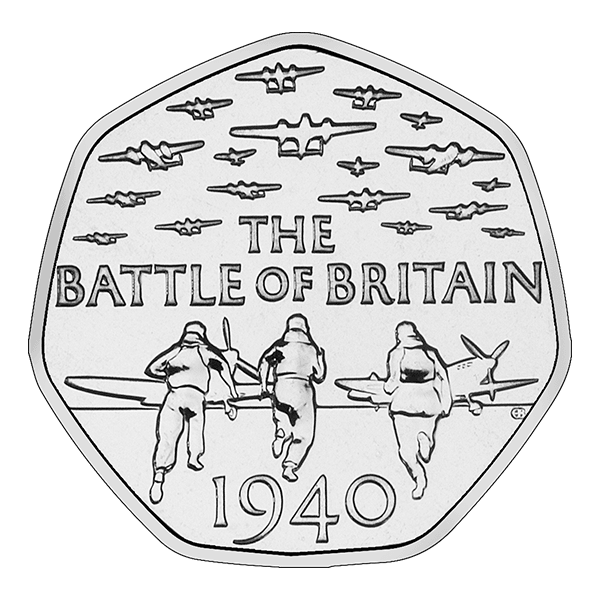On the 15th of September 1940, the Royal Air Force (RAF) fought what is now known as the Battle of Britain. In order to commemorate this event, the Royal Mint released a 50p coin in 2015.
It's been 80 years since the Battle of Britain, one of the most pivotal moments in our history. To commemorate this, the Royal Mint released a special 50p coin in 2015. Here's everything you need to know about this significant piece of currency.
How much is it worth today?
According to the most recent online sales on eBay and Amazon this coin is worth around £3.20 in good circulated condition.
In this article we take a look at the story behind the coin, the design of the coin and how likely you are to find one of these coins in your change. Plus, did you know this coin has 4 different obverses? Let's find out why.
History behind the coinBritain was in danger of invasion in the summer of 1940. The Battle of Britain had begun, and it would be up to the gallant young pilots and their crews to defend the nation's defenses. Who can imagine the world today if they had failed in their mission? It was their best moment.
A significant air conflict of the Second World War was the Battle of Britain. fought between 10 July and 31 October 1940 over the skies of Britain and the English Channel. In the history of mechanized conflict, the conflict is recognized as the first significant battle fought exclusively with air power.
Hitler and his generals prepared Operation Sea Lion, a full-scale assault of Britain, when France fell to them in 1940. The Fuhrer was aware that any expeditionary force would be wiped out by the Royal Navy and RAF's superior numbers unless the Luftwaffe gained control of the skies over southern England and the English Channel.
The Fleet Air Arm (FAA) of the Royal Navy and the Royal Air Force fought side by side day and night to repel the Luftwaffe and stop the first invasion of mainland British territory in decades.
Nazi Messerschmitts, Junkers, and Focke-Wulf aircraft engaged in head-to-head combat with British Spitfires and Hurricanes. Despite having a roughly 40% numerical advantage, Allied forces severely damaged the German aircraft.
The Allies lost over 1,700 planes and bombers, while the Luftwaffe lost close to 2,000. 735 German troops and airmen were hurt, and 925 were taken prisoner from downed planes in the English Channel and on British soil.
All parties realized that the Nazis' attempt to dismantle the RAF had fallen short by mid-September. Hitler formally delayed the invasion indefinitely on September 17, 1940—the day that is recognized as the conclusion of the battle—since the RAF's fighter plane output exceeded that of its losses.
Surprisingly, the RAF had more aircraft at the end of the war than it did at the beginning. The heroic actions of the RAF and the enormous industrial effort to build replacement aircraft had prevailed. Hitler would never again try to invade Britain or throw the Luftwaffe against Fighter Command when it was at its most powerful.
Design of the 2015 Battle of Britain 50p coin
Gary Breeze, a sculptor, created the image on the reverse. A squadron of Lancaster bombers sweeps overhead as the viewer sees three airmen racing away from the camera. In the center of the coin are the words 'THE BATTLE OF BRITAIN,' and below the airmen is etched the year '1940.'
The 2015 Battle of Britain coin is the first of Breeze's designs for the Royal Mint to reach final production. He has worked on a number of other designs. On his website, the artist stated that the Battle of Britain 'in some ways appeals to our intrinsic satisfaction at victory despite terrible odds. I wanted to celebrate that, but there was something missing.'
The design process, according to Breeze, 'I spent some time thinking on ideas based around the aircraft but they didn't communicate enough about the relevance of the Battle to us today."
Breeze's brother Lee Breeze, an enthusiastic coin collector, proposed that the design should put more emphasis on people than on airplanes.
4 Different Obverse designs
Unusually this 2015 50p commemorative coins has 4 different obverses.
Version 1 is the obverse design for the Silver Proof version of this coin.
It features the Jody Clark's Fifth portrait of Her Majesty the Queen without a denomination.

Version 2 is the brilliant uncirculated version, which features Ian Rank-Broadley's Fourth Portrait of the Queen Elizabeth II. This also does not have a denomination on any part of the coin, obverse or reverse.

Version 3 was used for the 5.9 million coins that entered general circulation, featuring Jody Clark's 5th Portrait of Queen Elizabeth II with the 50 PENCE denomination on the left hand side of the obverse of the coin.

And finally, version 4 as The Battle of Britain 50p was reissued by the Royal Mint in 2019 as part of their military coin set to mark both the 75th anniversary of D Day and the 50th Anniversary of the 50p, so the date is visibly different to represent the year on the obverse. The rest of the coin is unchanged from 2015.

The currency is a part of the Royal Mint's Military History collection, which also includes 50p coins commemorating the Battle of Hastings in 2016, the VC Medal 50p and VC Heroic Acts 50p coins from 2006, and the D-Day 50p from 1994.
The 4th and 5th Royal Shield portrait coins were the only other 50p pieces issued this year.
Mintage of the Coin
The 2015 edition of the Battle of Britain 50p has a mintage of 5,900,000. The 4th and 5th Royal Shield portrait coins were the only other 50p pieces issued this year and between them had a mintage of nearly 60 million.
A gold proof, silver proof, and silver piedfort version were also created by the Royal Mint, with mintages of 520, 1,969, and 1,940, respectively.
In the same year, the Royal Mint issued three commemorative £2 coins; the Magna Carta £2 coin and the First World War Navy £2 coin.
2015 was also the year where the Technology £2 was phased out and the new Britannia £2 coin was issued. For this reason, the mintage of the 2015 Britannia £2 was incredibly low at just 650,000, making this an extremely rare coin indeed.
Is the 2015 Battle of Britain 50p Coin Rare?
With a mintage of 5.9 million the coin is not particularly rare in comparison with some other commemorative coins such as the 2016 Jemima Puddle-duck 50p or the 2017 Isaac Newton 50p coin that both have a mintage around 2 million.
It has a similar mintage to the 2019 Paddington at the Palace 50p which had just 1,000 more and a mintage of 5,901,000 and the 2016 Team GB 50p coin which had a mintage of 6.4 million.
Nevertheless, it is not a very common coin to receive in your change and it is more than face value and a wonderful coin to add to your collection.
How Much Is the Battle of Britain 50p Coin Worth Today?
As we said, it is always it is difficult to put an exact price on a coin as all coins vary in condition, but we would expect the circulated Battle of Britain 50p to be worth around £3.20 in today's market excluding any postage costs, nearly 4 times it's face value, despite only being issued 7 years ago.
Where Can I Buy the 2015 Battle of Britain 50p Coin?You can buy this coin directly from ourselves by clicking here.
You can buy the Battle of Britain 50p coin online on auction sites such as eBay or Amazon but please ensure you look at all the information and reputation of the seller.
Unfortunately, as this coin is now nearly 8 years old, the Royal Mint no longer stock this coin so it is only available to buy on the secondary market.
Are there any known errors of this coin?
The Royal Mint has not confirmed any error versions of the 2015 Battle of Britain 50p, so any listings on eBay or Amazon that are trying to market an ‘error’ version are trying to trick buyers and artificially inflate the price.
However, as we have discussed, there are a number of different obverses.
Bit of Trivia...
Nearly 3,000 men of the RAF took part in the Battle of Britain – those who Winston Churchill called ‘The Few’.
While most of the pilots were British, men came from all over the Commonwealth and occupied Europe – from New Zealand, Australia, Canada, South Africa, Rhodesia (now Zimbabwe), Belgium, France, Poland and Czechoslovakia. There were even some pilots from the neutral United States and Ireland.

